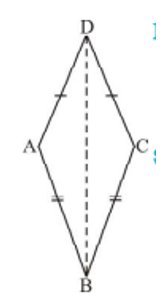In Fig. 6.53 ∠1 = ∠ 2 and ∠ 3 = ∠ 4. i Is ΔADC ≅ ΔABC? Why ? ii Show that AD = AB and CD = CB.
Related Solutions
In Figure,

. (i) Is? Why ?
(ii) Show that AD = AB and CD = CB.View SolutionIn fig Ad = CD and AB = CB.
Is ? Why or why not?
 View Solution
View SolutionIn Fig. LM || CB and LN ||CD , prove that .
 View Solution
View SolutionIn Fig , if , prove that
 View Solution
View SolutionIn Fig. , if and ,prove that
 View Solution
View Solution
In the fig. if LM || CB and LN || CD, prove thatView SolutionIn Fig. 4.134, and . Prove that (FIGURE)
View SolutionIn Fig.6.53,ABD is a triangle right angle at A and .Show that
 (i).View Solution
(i).View SolutionIn Fig. 5.65 , show that
(i) AB ||CD
(ii) EF || GH
 View Solution
View SolutionName the following reaction. AB + CD to AD+ CB
View SolutionIn the given figure, and AB=CD. Prove that :
(i)
(ii) AD-CB
 View Solution
View SolutionIn the given figure, AB=CD and AD=CB. Prove that :
(i)
(ii)
 View Solution
View SolutionIn Fig. 4.122, and are respectively perpendiculars to and . Show that: (FIGURE) (ii) (iii) (iv)
View SolutionIn fig Ad = CD and AB = CB.
Does BD bisect ? Give reasons.
 View Solution
View SolutionIn fig Ad = CD and AB = CB.
State the three pairs of equal parts in and .
 View Solution
View Solutionआकृति में AD = CD और AB = CB है।

क्या हैं ? क्यों अथवा क्यों नहीं?View SolutionOne mole of a compound AB reacts with 1 mole of a compound CD according to the equation .
When equilibrium had been established it was found that mole each of reactant AB and CD has been converted to AD and CB. There is no change in volume. The equilibrium constant for the reaction isView SolutionIn fig 7.13, (i) state the three pairs of equal in (iii) Is ? Why or why not ? (iii) Does bisect ? ? Given reasons
View SolutionIn the given figure, (i) state the three pairs of equal in (iii) Is ? Why or why not ? (iii) Does bisect ? ? Given reasons
 View Solution
View SolutionIn the Fig.

If . Prove that .View Solution
